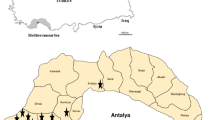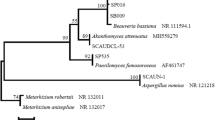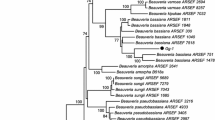Abstract
Cardamom thrips (Sciothrips cardamomi Ramk.) (Thysanoptera: Thripidae) cause serious economic loss to cardamom, Elettaria cardamomum (L.) Maton (Zingiberaceae). A fungus was isolated from cadavers of cardamom thrips collected during a survey in cardamom plantations of Wayanad District, Kerala, India and identified as Lecanicillium psalliotae (Treschew) Zare & W. Gams (Ascomycota: Hypocreales) based on morphological and molecular studies. Bio-assay studies with purified conidial suspension further confirmed the infectivity of the fungus to thrips. At the highest dose tested (1 × 107 conidia ml−1), up to 62.9 % mortality was recorded in the test population, ten days post inoculation. The fungal pathogenesis on adult thrips was documented by scanning electron microscopic studies. This is the first record of L. psalliotae in India and also a first report of a fungus infecting cardamom thrips.



Similar content being viewed by others
References
Abbott WS (1925) A method of computing the effectiveness of an insecticide. J Econ Entomol 18:265–267
Aquino de Muro M, Elliott S, Moore D, Parker BL, Skinner M, Reid W, Bouhssini M (2005) Molecular characterisation of Beauveria bassiana isolates obtained from overwintering sites of Sunn Pests (Eurygaster and Aelia species). Mycol Res 109:294–306
Arevalo J, Hidalgo-Díaz L, Martins I, Souza JF, Castro JMC, Carneiro RMDG, Tigano MS (2009) Cultural and morphological characterization of Pochonia chlamydosporia and Lecanicillium psalliotae isolated from Meloidogyne mayaguensis eggs in Brazil. Trop Plant Pathol 34:158–163
Asad EM, Zafari DM, Zare R (2008) First report of Lecanicillium psalliotae as an entomogenous fungus from Iran. Rostaniha 9:119
Asensio L, Lopez-Llorca LV, Lo´pez-Jime´nez JA (2005) Use of light, scanning electron microscopy and bioassays to evaluate parasitism by entomopathogenic fungi of the red scale insect of palms (Phoenicococcus marlatti Ckll., 1899). Micron 36:169–175
Askary H, Benhamou N, Brodeur J (1999) Ultrastructural and cytochemical characterization of aphid invasion by the hyphomycete Verticillium lecanii. J Invertebr Pathol 74:1–13
Bidochka MJ, Kamp AM, Lavender TM, Dekoning J, De Croos JNA (2001) Habitat association in two genetic groups of the insect pathogenic fungus Metarhizium anisopliae: uncovering cryptic species? Appl Environ Microbiol 67:1335–1342
Boucias D, Pendland JC (1991) Attachment of mycopathogens to cuticle. In: Cole GT, Hoch HC (eds) The fungal spore and disease initiation in plants and animals. Plenum Press, New York, USA, pp 101–127
Dharmadasa M, Nagalingam T, Seneviratne PHM (2008) Identification and screening of new generation insecticides against cardamom thrips (Sciothrips cardamomi) in cardamom cultivations in Sri Lanka. Ceylon J Sci (Biol Sci) 37:137–142
Glass NL, Donaldson GC (1995) Development of primer sets designed for use with the PCR to amplify conserved genes from filamentous ascomycetes. Appl Environ Microbiol 61:1323–1330
Gopakumar B, Chandrasekar SS (2002) Insect pests of cardamom. In: Ravindran PN, Madhusoodanan KJ (eds) Cardamom—the genus Elettaria. Taylor and Francis, London, UK, pp 180–206
Gouli S, Gouli V, Skinner M, Parker B, Marcelino J, Shternshis M (2008) Mortality of western flower thrips, Frankliniella occidentalis, under influence of single and mixed fungal inoculations. J Agric Technol 4:37–47
Jeffs LB, Xavier IJ, Matai RE, Khachatourians GG (1999) Relationships between fungal spore morphologies and surface properties for entomopathogenic members of the genera Beauveria, Metarhizium, Paecilomyces, Tolypocladium and Verticillium. Can J Microbiol 45:936–948
Kheirabadi PK, Haddadzadeh H, Razzaghi-Abyaneh M, Bokaie S, Zare R, Ghazavi M, Shams-Ghahfarokhi M (2007) Biological control of Rhipicephalus (Boophilus) annulatus by different strains of Metarhizium anisopliae, Beauveria bassiana and Lecanicillium psalliotae fungi. Parasitol Res 100:1297–1302
Kouvelis VN, Sialakouma A, Typas MA (2008) Mitochondrial gene sequences alone or combined with ITS region sequences provide firm molecular criteria for the classification of Lecanicillium species. Mycol Res 112:829–844
Krishnamurthy K, Khan MM, Avadhani KK, Venkatesh J, Siddaramaiah AL, Chakravarthy AK, Gurumurthy BR (1989) Three decades of cardamom research at Regional Research Station, Mudigere. University of Agricultural Sciences, Bangalore, India, 94 p
Kushwaha RKS (1980) A new species of Verticillium. Curr Sci 49:948–949
Maniania NK, Sithanantham S, Ekesi S, Ampong-Nyarko K, Baumgartner J, Lohr B, Matoka CM (2003) A field trial of the entomogenous fungus Metarhizium anisopliae for control of onion thrips, Thrips tabaci. Crop Prot 22:553–559
Murugan M, Shetty PK, Ravi R, Subbiah A, Hiremath MB (2011) Environmental impacts of intensive cardamom (small) cultivation in Indian cardamom hills: the need for sustainable and efficient practices. Recent Res Sci Technol 3:9–15
Nagaoka T, Nakata K, Kouno K, Ando T (2004) Antifungal activity of oosporein from an antagonistic fungus against Phytophthora infestans. Z Naturforsch C 59:302–304
North JP, Cuthbertson AGS, Walters KFA (2006) The efficacy of two entomopathogenic biocontrol agents against adult Thrips palmi (Thysanoptera: Thripidae). J Invertebr Pathol 92:89–92
Posadas JB, Comerio RM, Mini JI, Nussenbaum AL, Lecuona RE (2012) A novel dodine-free selective medium based on the use of cetyl trimethyl ammonium bromide (CTAB) to isolate Beauveria bassiana, Metarhizium anisopliae sensu lato and Paecilomyces lilacinus from soil. Mycologia 104:974–980
Rehner SA, Buckley E (2005) A Beauveria phylogeny inferred from nuclear ITS and TEF-α sequences: evidence for cryptic diversification and link to Cordyceps teleomorphs. Mycologia 97:84–98
Saito T, Takatsuka J, Shimazu M (2012) Characterization of Paecilomyces cinnamomeus from the camellia whitefly, Aleurocanthus camelliae (Hemiptera: Aleyrodidae), infesting tea in Japan. J Invertebr Pathol 110:14–23
SAS (2011) SAS/STAT Software. Release 9.3. SAS Institute Inc., Cary, NC, USA
Steenberg T, Humber RA (1999) Entomopathogenic potential of Verticillium and Acremonium species (Deuteromycotina: Hyphomycetes). J Invertebr Pathol 73:309–314
Sukarno N, Kurihara Y, Ilyas M, Mangunwardoyo W, Yuniarti E, Sjamsuridzal W, Park J-Y, Saraswati R, Inaba S, Widyastuti Y, Ando K, Harayama S (2009) Lecanicillium and Verticillium species from Indonesia and Japan including three new species. Mycoscience 50:369–379
Sung GH, Nigel LHJ, Sung JM, Luangsa-Ard JJ, Shrestha B, Spatafora JW (2007) Phylogenetic classification of Cordyceps and the clavicipitaceous fungi. Stud Mycol 57:5–59
Tamura K, Peterson D, Peterson N, Stecher G, Nei M, Kumar S (2011) MEGA5: molecular evolutionary genetics analysis using maximum likelihood, evolutionary distance, and maximum parsimony methods. Mol Biol Evol 28:2731–2739
Thomas MB, Read AF (2007) Can fungal biopesticides control malaria? Nat Rev Microbiol 5:377–383
Vestergaard S, Butt TM, Bresciani J, Gillespie AT, Eilenberg J (1999) Light and electron microscopy studies of the infection of the western flower thrips Frankliniella occidentalis (Thysanoptera: Thripidae) by the entomopathogenic fungus Metarhizium anisopliae. J Invertebr Pathol 73:25–33
White TJ, Bruns T, Lee S, Taylor J (1990) Amplification and direct sequencing of fungal ribosomal RNA genes for phylogenetics. In: Innis MA, Gelfand DH, Sninsky JJ, White TJ (eds) PCR protocols: a guide to methods and applications. Academic Press, San Diego, USA, pp 315–322
Yang J, Huang X, Tian B, Wang M, Niu Q, Zhang K (2005) Isolation and characterization of a serine protease from the nematophagous fungus, Lecanicillium psalliotae, displaying nematicidal activity. Biotechnol Lett 27:1123–1128
Zare R, Gams W (2001) A revision of Verticillium section Prostrata. IV. The genera Lecanicillium and Simplicillium gen. nov. Nova Hedwig 73:1–50
Zheng CJ, Xia JW, Sen L (2012) Identification of fungus Lecanicillium psalliotae and its colonization in different life stages of Meloidogyne incognita. Sci Agric Sin 45:2404–2411
Acknowledgments
The work was carried out under a grant of ICAR under an Outreach Programme on Sucking Pests of Horticultural Crops. We thank Director, IISR for necessary facilities, Dr. Rasoul Zare, Iranian Research Institute of Plant Protection for relevant literature and Dr. R. Ramakrishnan Nair for photomicrograph facility. Technical help extended by Distributed Information Sub-Centre, K.K. Sasidharan, K. Jayarajan (IISR) and K. B. Rebijith (IIHR, Bengaluru) are greatly acknowledged. Thanks are due to Dr. A. Dhandapani, National Academy of Agricultural Research Management, Hyderabad for statistical analysis. We thank the anonymous reviewers and editor for their valuable comments which helped to improve the manuscript.
Author information
Authors and Affiliations
Corresponding author
Additional information
Handling Editor: Helen Roy.
Rights and permissions
About this article
Cite this article
Senthil Kumar, C.M., Jacob, T.K., Devasahayam, S. et al. Isolation and characterization of a Lecanicillium psalliotae isolate infecting cardamom thrips (Sciothrips cardamomi) in India. BioControl 60, 363–373 (2015). https://doi.org/10.1007/s10526-015-9649-4
Received:
Accepted:
Published:
Issue Date:
DOI: https://doi.org/10.1007/s10526-015-9649-4




